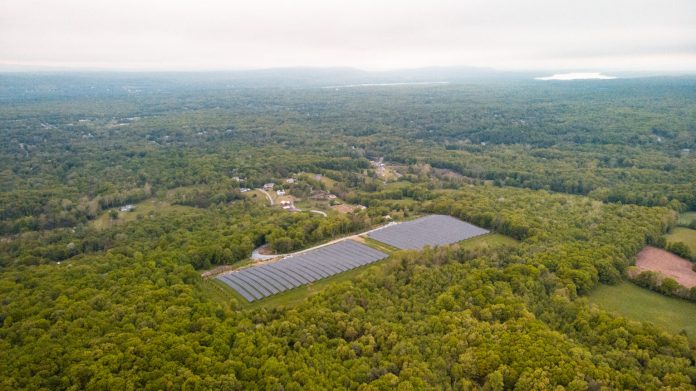Rural farmland in the U.S. is under attack from climate change and a suburbanizing landscape. Between 2001 and 2016, residential and commercial development consumed 11 million acres of farmland. Another 18 million acres could succumb to new developments by 2040. According to the American Farmland Trust, climate change and extreme weather events make farming and ranching more challenging, with AFT’s research showing a significant swath of rainfed agricultural land will be less likely to support current growing systems by 2040.
And if that was not enough, the U.S. is currently in the midst of an intergenerational transfer as millions of acres of farmland change hands as baby boomer farmers retire, making farmland vulnerable to development as not many children of farmers seek to take the reins on the family farmstead, said Ethan Winter, National Smart Solar Director of AFT at the first Solar Farm Summit, a U.S. agrivoltaics conference held on March 14 in Rosemont, Illinois.
Lightstar Renewables, a Boston-based community solar developer, is partnering with AFT in order to preserve rural farmland for agriculture and community solar development co-located on farmland, also known as Agrivoltaics.
Under the partnership, AFT will use its Smart Solar principles to guide Lightstar on policy, research, and farmer engagement initiatives “to accelerate agriculturally-compatible solar energy development” and promote sustainable farming and ranching practices.
Speaking with pv magazine USA at the Solar Farm Summit, Lucy Bullock-Sieger, vice president of strategy for Lightstar, said the four-year old company has developed 31 agrivoltaic projects out of a 208 MW active development portfolio consisting of community and agrivoltaic projects, while the Magnetar Financial-backed company has a multi-year portfolio of committed projects with 600 MW of total power capacity.
Under the AFT partnership, Lightstar aims to empower farmers with regenerative agricultural practices that includes co-located agrivoltaic solar projects on farmland in New York, Maryland and Illinois. Bullock-Sieger said the northeast-focused developer is talking to scores of rural farmers about the solar opportunity to bolster their cash business and supplement crop yields at a higher growth rate in the coming decades.
The agrivoltaics market is establishing a “compliance mechanism between us and farmers,” Bullock-Sieger said. “We’re not going to put a hunk of steel in the ground and run,” Bullock-Sieger joked about a prior misperception rural farmers had about solar development.
“Five years from now, we don’t want farmers asking, ‘what do we do now that a turnkey project is in the ground?’” said Bullock-Sieger. Lightstar forges a relationship with host farmers by promoting and implementing new seed varieties for crop produce, and offering other vegetation management solutions that could improve the property’s resistance to erosion or climate change factors.
Building trust with multi-generational family farm owners is based on tax compliance regulations, Bullock-Sieger said, while farmers typically iron out a long-term plan to continue to cultivate from the land for decades to come. Farmers keen on agrivoltaics are often either near retirement age or whose children see the revenue potential from dual-use agrivoltaic applications, she said.
Like community and utility solar projects, agrivoltaic projects assembled by Lightstar and other developers will typically take a 20-year contractual lifespan in which the developer will continue to actively maintain the facility and farmland property with the owner-operator, Bullock-Sieger said.
In upstate New York, Bullock-Sieger says Lightstar will be developing a 3.6 MW (DC) solar array by early 2024 on a 16-acre plot for DiMartino Farms, a 125-acre family-operated hay and small vegetable farm in Montgomery, N.Y., in the western Hudson Valley region. She said the Hudson Valley development involved children of the farm’s owners stepping forward to preserve the farm’s crop yield. The rural farm also stands to generate new income sources from Lightstar-grown vegetable crops, pumpkins to be seeded, as well as on-site solar arrays to lower the farm’s energy bill.
Dual-use agrivoltaic projects also provide tax revenue at the local municipality level, increase energy independence and grid security.
The AFT is a 501(c)(3) non-profit organization formed in 1980 by farmers, ranchers and conservationists Peggy Rockefeller, Patrick Noonan and William K. Reilly, to provide agricultural landowners with environmentally-sound resources, promote land conservation and utilize local solar power resources.
In August 2020, the AFT launched the “Farming Is Our Future” campaign with a goal to double the amount of permanently protected farmland and reduce current loss by 75%. At the same time the nonprofit adopted regenerative practices including Agrivoltaics at scale so that farmers capture more carbon than they emit. Meanwhile, the AFT set out to bring 600,000 new farmers and ranchers into the market by 2040 based on the intergenerational shift away from farming culture in recent decades.
The AFT recently published a solar leasing guidebook for agricultural landowners for the Pacific Northwest market.
Brian Ross of the Great Plains Institute said the U.S. currently has 5 million acres of rural farmland whose land use is governed at the county level for solar development, presenting a large opportunity for the co-location of agrivoltaic projects over existing farm operations.
On a county wide basis, only 4% of Illinois land is currently utilized for solar development, Ross added.






